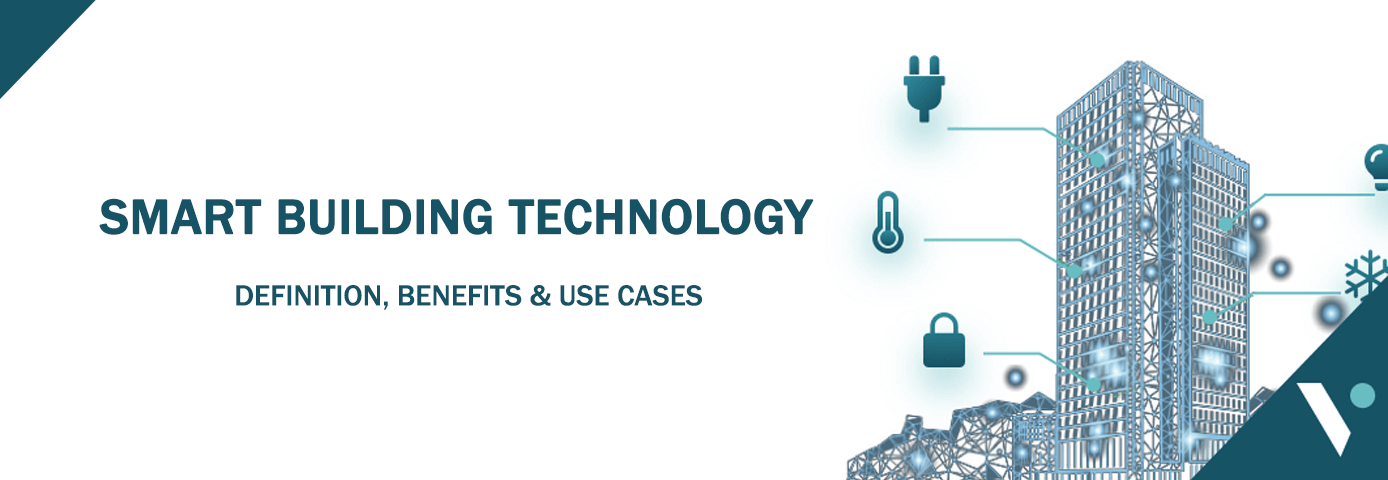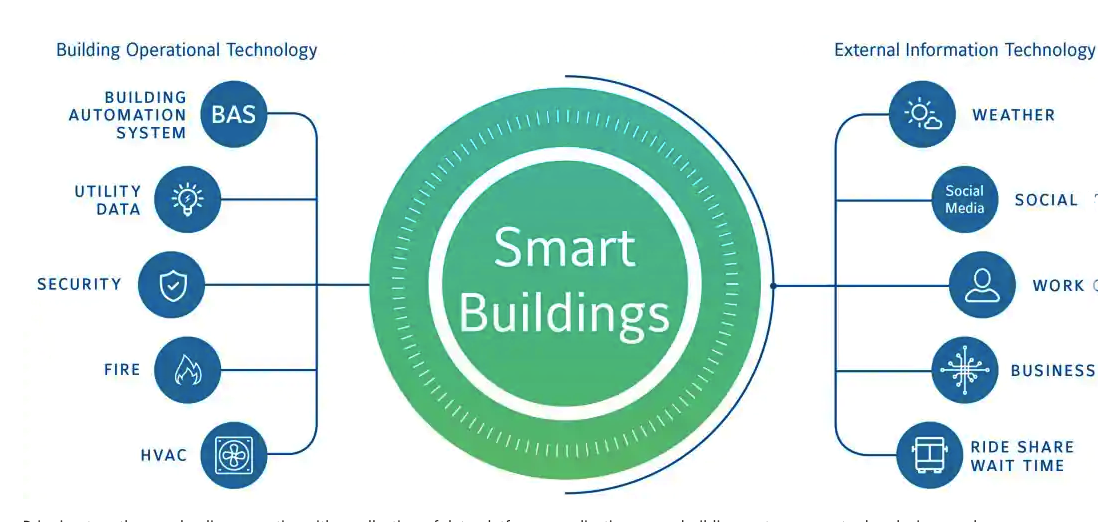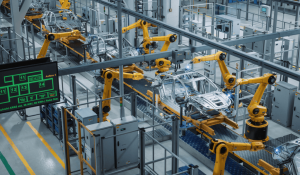Complete guide to smart buildings technology

In the digital era, it is no longer enough for buildings to just provide space, keep occupants warm, and please the eye. New demands require the digital market to offer advanced complex solutions like smart buildings. What are they and are they any better than the usual buildings and offices? Let’s dive deeper into the topic.
What is a smart building?
The definition of smart building is still vague as intelligent building technology is evolving every year. So, what are smart buildings? In fact, these are commercial buildings equipped with smart sensors and various devices connected to the internet. The IoT devices can help with monitoring systems, centralized control of the HVAC system, facilities management, smart parking, measuring the building performance, fire alarms, and more.
What’s the difference between a smart home and a smart building
The smart home encompasses the automation of various routines within a household, or for individual usage. In contrast to smart homes, smart building technologies are used for commercial purposes. The range of smart building applications is wider than those used for smart homes. For example, commercial buildings include measuring various indexes on how the building is performing, while smart homes usually don’t need such analytics.
The main characteristics of smart buildings
What makes a building smart? Here are some of the smart building technology features.
Connectivity
All crucial intelligent building systems are “smart” and interconnected. Building managers can access control systems remotely from a centralized digital platform called a building management system.
Sensors
Smart actuators and sensors are built into the building’s physical parts and can serve to control or track any aspect, like lighting, air conditioning, security cameras, and building resources.
Automation
IoT devices are set to automate building operations. The building systems can function independently and manage themselves without human intervention: automatically adjust the temperature, turn on and turn off the lights, open and close the doors, and more.
Visualization dashboard
Smarter buildings can also have a centralized building management system to visualize the smart building data and give the tenants insights into the energy consumption, building efficiency, or maintenance required.

What technologies are used in smart buildings?
IoT is the main technology in buildings we call smart. If you still think that smart buildings should only be modern and newly built, it’s no longer the truth. Older existing buildings can also become smart by adopting the following technologies.
Internet of Things (IoT)
IoT is the main smart tech, a basic technology that runs the building. Due to IoT, sensors, network connections, and dashboards a building can have automated processes and become “smart.” The applications of IoT range from reducing energy usage, implementing smart lighting, or controlling air quality to improving business operations using sensor data collected from IoT devices.
Artificial intelligence and machine learning
AI integrates perfectly with the IoT environment to make even more personalized adjustments to the automation patterns or occupants’ behavior. For instance, AI can be used for predictive maintenance and warn about any system abnormality, equipment malfunction, or breakage. AI can “learn” what normal functioning is and warn if it finds any inconsistencies.
Augmented reality
AR is a powerful tool that can be used for educational purposes. For example, staff of a plant or laboratory can interact with virtual equipment and train in a safe environment before getting to the real equipment. Another AR application is navigation through the building. AR glasses can prompt for the right directions in a huge building and its surroundings which will help visitors and new employees find the way faster.
Robotics
This one is still quite an advanced thing, yet robots are used for a variety of tasks. For the most part, robots do some tiresome or hazardous jobs like carrying weights, cleaning, or disinfection. With robotic assistance, people working in the smart building can focus on complex tasks that require human intelligence instead of completing some no-brain routine tasks.
List of IoT solutions and opportunities for smart facilities
While the general principle of IoT is the same — connecting a device to the network and automating a task — different domains can benefit from smart buildings technology in different ways. Let’s consider some examples of how IoT can help in commercial real estate.
Solutions for business centers and offices
IoT in business centers and smart offices reduces energy consumption, making the work more comfortable, efficient, and distraction-free. Here are some examples.
HVAC management
The system allows maintaining the pre-set temperature not only in the whole building but also in specific sub-zones. For instance, if the temperature near a window is lower than expected, the smart HVAC systems will automatically adjust it only in that particular place and use only the resources necessary for this purpose while increasing energy efficiency.
Air quality monitoring
The smart sensors can check the carbon dioxide level in a room to ensure a healthy environment. When the level increases, the system increases the airflow accordingly so that the air quality is comfortable and safe for the people. This is especially convenient during meetings when large groups of people gather in a room and spend several hours there.
Lighting management
The daylight sensors can adjust the lighting levels more precisely and either turn on or off the light accordingly, depending on the daylight. This maintains the optimal lighting level all day long which meets two principal needs: energy saving and keeping the necessary illumination levels for the comfort work of the occupants.
Occupancy and optimizing space usage
Occupancy sensors collect data on the presence of people in a spot. When properly analyzed, the sensor data can show if the building space and resources are used optimally. Furthermore, if the occupancy sensors are integrated into a smart system, they can communicate with other sensors and switch off the lights, adjust ventilation, turn off heating, etc. as soon as they detect nobody using the resources.
Smart parking
Wireless sensors inside pavements, car counting tools, and cameras help car drivers find parking spaces faster or even book one beforehand. Looking for a parking space may distract drivers and lead to an accident, and smart parking minimizes the risk. This way the system solves several of the biggest drivers’ pain points.
Smart elevators
It’s not only about calling the elevator from the smartphone. Smart elevators can detect how many people are in it, and if the cabin is at capacity, the elevator won’t stop at another floor in vain. It’s also safer than a usual elevator: if anything isn’t right, it will notify the maintenance team beforehand so people aren’t stuck in the cabin.
Smart hotels
The purpose of a smart hotel will be quite different from that of a smart business center. On the one hand, it’s aimed at creating a better guest experience. On the other hand, it helps administrators and staff streamline the smart building management process. From a long-term perspective, the smart building solutions are to attract more guests and make the building more energy-efficient. Here are several IoT solutions for smart hotels.
Security and access
The digital cards are integrated into mobile apps that may have various functionalities. Apart from accessing the room, the app allows users to remotely lock the door and control other systems like air conditioning or water temperature.
Smart room
The smart room encompasses a huge variety of IoT-enabled devices: lightbulbs, air and water temperature controllers, curtains, TV, digital food menus, and more. Such systems allow guests to customize the room to cater to their specific needs. Sometimes it’s even possible to remember the guests’ preferences for future visits.
Self-check-in
Automated check-in has become almost a must-have option for hotels for good reason. The mobile hotel kiosks allow guests to check in whenever they want, sparing them the hassle of waiting in line in front of the reception. While a traditional check-in at the desk is still available, the automated check-in gives the visitors a choice of when and how to register. Besides, the smart hotel kiosk also allows requesting other amenities like additional towels or room service.
Automated asset tracking for hotel management
The NFC, QR, or barcodes allow staff to monitor the inventory and assets in guest rooms, track inventory stock, receive reminders to re-order the assets on time, track disposals, food, and beverages in guest rooms, and more. This helps the hotel administration deliver timely servicing and improve the business processes.
Smart warehouses
Smart warehousing is about implementing smart processes into the workflow. By choosing proper IoT solutions, many tasks can be automated, and this results in more streamlined operations and higher efficiency. Smart warehousing can eliminate the pen-and-paper way of doing business, which can reduce human error, lower the risks for employees, increase efficiency, and reduce labor costs. Here are some practical examples.
Robots and AI
As a rule, the warehouse robots do the low-skilled work: pick or pack goods, or carry them to a required spot. Robots can carry more goods at a time and move faster than a human, which significantly contributes to efficiency. The involvement of artificial intelligence can make the process even more efficient. The AI-enabled robots will be able to optimize the routes for carrying goods and find an appropriate size of the box for packaging.
Radio-frequency identification (RFID)
The RFID tags eliminate the need to track goods using pen and paper. Unlike the barcode tags that need to be precisely aligned with the scanner to be read, the RFID tags can be read on bigger distances. This allows to minimize human intervention and to automatically track the goods as they arrive. Automatic tracking is more precise and decreases the risk of human error.
Warehouse management system (WMS)
WMS is a multipurpose digital tool that allows for data analysis, making predictions, detecting bottlenecks or deficiencies, and more. It’s a convenient way to keep track of business operations: all the data is in one place, it is continually updated and is accessible anytime. The information in the system can give insights into possible improvements.
Smart building systems: 7 benefits
Sustainability
Due to improved smart building technology and better maintenance, the intelligent facility will serve longer.
Resource-efficiency
Intelligent building technology helps allocate only the necessary resources and reduce energy costs.
Carbon neutrality
Smart buildings help decrease greenhouse gas emissions since they use the minimum required power to function.
Higher safety
Smart tech helps prevent accidents caused by human error and devices like robots can take over dangerous tasks.
Higher competitiveness
Modern tenants value comfort and digitization so smart technologies are a benefit for building owners.
Long-term perspective project
Smart buildings are at the dawning and the project started now will still serve well the future generations.
The risks of smart building technology
No system is foolproof, nor are intelligent buildings. Here are the important aspects to take into account:
Smart devices are entirely dependent on electricity and network. Think about backups for vital functions in case of electricity shortage or network issues.
Some devices don’t offer built-in protection. Consider the additional security for such devices.
Default passwords for IoT devices are weak and can be easily brute-forced. It’s recommended to use two-factor authentication where possible.
The smart building is as safe as its weakest link. Don’t overlook a thing while projecting security for your facility.
Old devices put the system at risk as they don’t get updates and security patches. Choose the newest technologies for a long perspective.
Connecting devices or using solutions from different vendors can represent a challenge. It’s recommended to check out the compatibility beforehand.
Hardware, software, and network have to work together. Make sure you entrust the IoT development to a reliable provider.
The future of the smart building industry
The smart building industry is evolving and the smart building market is predicted to grow at a CAGR of 11.3% from 2022 to 2031. Buildings of the future tend to be smarter and more connected. The main reason for adopting smart building technologies is to reduce the carbon footprint and it does make sense. Automation helps use resources more efficiently while not sacrificing the comfort of the building tenants.
Smart technologies enhance the tenants’ well-being by promoting a more people-focused and personalized approach. Furthermore, smart buildings are more fitted to the hybrid culture which aligns with the post-pandemic need for a more flexible approach.
Buildings have undergone significant changes in recent years, with the emergence of smart technology paving the way for more sustainable, cost-effective, and healthy spaces. The rise of smart buildings is set to address individual concerns, such as productivity and costs, while also reducing environmental harm. We’re now creating the smart buildings of tomorrow.
Bottom line. IoT in commercial buildings creates a safer, more productive, and more comfortable facility that will pay off on multiple levels — from adding to the comfort of the building occupants to reducing the carbon footprint. Smart building technology creates a better experience for all people involved. From a business perspective, smart buildings are worth investing in, and it’s a perfect time to start off with a smart facility project.




